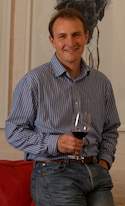Vintage 1992 was David Trafford's first 'official' vintage if wines made for the market is the criterion applied, but this qualified architect, who was still practicing until a few years ago, has been making wine for close to 30 years. What started as a 'hobby' is factored into the equation.
Vintage 20

It all began when his parents, Alastair and Maviz Trafford, bought the 200-hectare Mont Fleur farm in 1976, realising a long-held dream of establishing a wine farm. What was to become the home of De Trafford wines lies at the end of a winding, seemingly never-ending track through lush riverside vegetation and an oak forest up the narrow Blaauwklip Valley between the Stellenbosch and Helderberg mountains.
The family had moved down to the Cape from KwaZulu-Natal when David was 13. After completing his schooling at Diocesan College (Bishops), he went on to study architecture at the University of Cape Town.
While his father was converting former grazing land into what was to become one of the Cape's largest vine rootstock mother plantations to supply nurseries and other growers with new plant material, David started making red wine 'for consumption and friends'. He bought in grapes before he and his father decided to plant their own tiny vineyard in 1983: some three hectares of mainly cabernet sauvignon, cabernet franc, merlot, and pinot noir.
A record of his early 'trial and error attempts, rendered with David's typically dry sense of humour, reads as follows: in '84 a barrel of cabernet exploded; the '85 crop refused to ripen 'and thankfully our entire production was stolen'; '86 sugars were excessive and had to be diluted; '87 was lost entirely to the birds.
David graduated in 1988 and, while working for an architectural firm in London, spent the 1989 northern hemisphere pressing season at Château Soutard in Saint-Émilion, Bordeaux. Upon his return to Mont Fleur and an architectural career in Cape Town, he continued his weekend experiments with winemaking.
He read up and gleaned practical tips from 'exceedingly kind and helpful but I think rather bemused, and perhaps frustrated vintners'. These included former Meerlust cellarmaster Giorgio Dalla Cia and Etienne le Riche [a member of the Guild, which the persistent young winemaker was eventually invited to join in 2000].
Rustic Sophistication
David persevered with his 'rustic' methods. Vinifying only what could be made in barrel (thus focussing on reds initially), he kept things au naturel: using a homemade hand crusher/destemmer and a small basket press; fermenting in oak with wild yeasts only; employing a hand pump for gentle racking; fining with natural egg white; leaving his wines unfiltered; designing his own labels, affixed by hand.
In 1991 he constructed a small, partly underground winery tunnelled out of a slope. Until then he'd been using a cobwebbed outbuilding attached to his equally 'rustic' bachelor's pad, keeping an eye on his wines through a handy hatchway an arm's length from his architect's drawing board.
Vintage 1992 saw his first commercially made wines under the De Trafford label: Cabernet, Merlot, Pinot Noir, and a red blend, released in 1993 under labels designed by the winemaker himself.
In the two decades since then, David has remained true to his original winemaking philosophy. Using non-interventionist methods in largely the same, essentially artisanal winery (now slightly expanded for storage), he remains intent on expressing a sense of place in-his wines. 'I try to understand and work with the vineyard to coax something magical from the land; after that it's: hold thumbs I don't cock it up in the cellar.'
From his initial 300 cases, he's 'grown' to just 3 500 12-bottle packs of De Trafford wines. These still come from selected grapes from three specific Stellenbosch and Helderberg vineyards, as well as the original plantings on Mont Fleur's mountainsides.
A smidgen of shiraz and pockets more of cabernet, cabernet franc, and merlot were subsequently added to bring the Mont Fleur vineyard to a grand ·total of five hectares. These high-lying young vines were planted on carefully chosen virgin soil and are the source of his signature De Trafford wines: the Syrah 393 and the Elevation 393 (a traditional Bordeaux mix of varieties with Shiraz). The names refer to the home vineyard's altitude.
Shiraz, he confesses, is the variety that most enthralls him, and it shows: his De Trafford Shiraz 2007, now renamed the Syrah 393, scored an almost unheard-of-for-the-Cape 95 [on the 100-point scale] in leading American wine publication Wine Spectator in 2010.
David continues to live with his wines, though as they gained in volume and stature, their maker retreated further up the gully to the homely but creative eyrie he designed and built right beside his Shiraz vineyard at 'elevation 393 m' in 1999.
 South African traditional Durban curry recipe by cellar master David Trafford paired with Sijnn Rosé wine....
South African traditional Durban curry recipe by cellar master David Trafford paired with Sijnn Rosé wine.... Pork belly recipe by David Trafford with roasted sweet corn and red pepper salsa served with roast sweet potatoes and dates....
Pork belly recipe by David Trafford with roasted sweet corn and red pepper salsa served with roast sweet potatoes and dates....